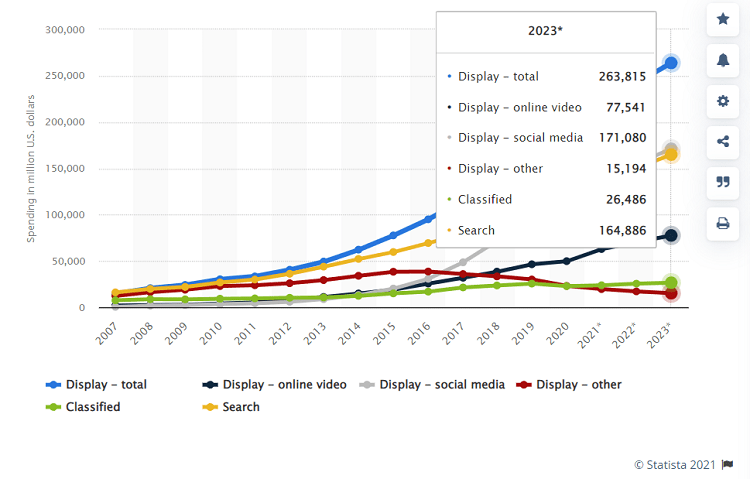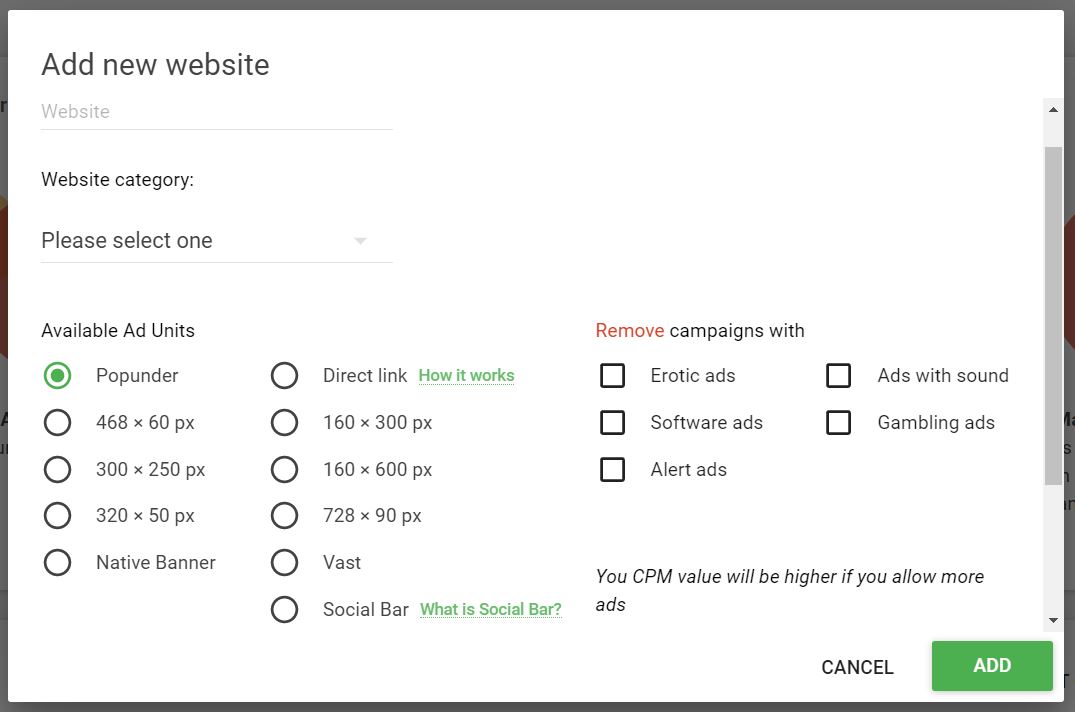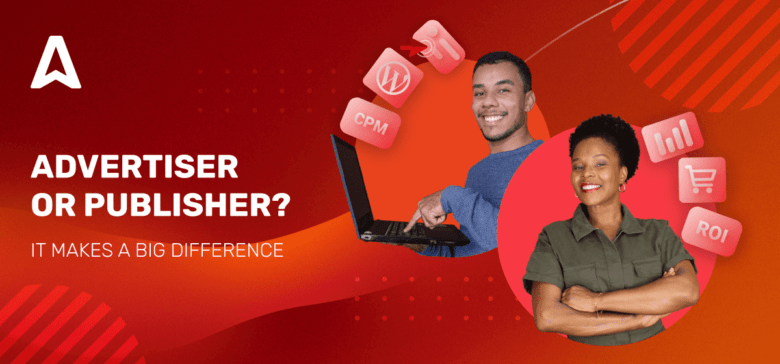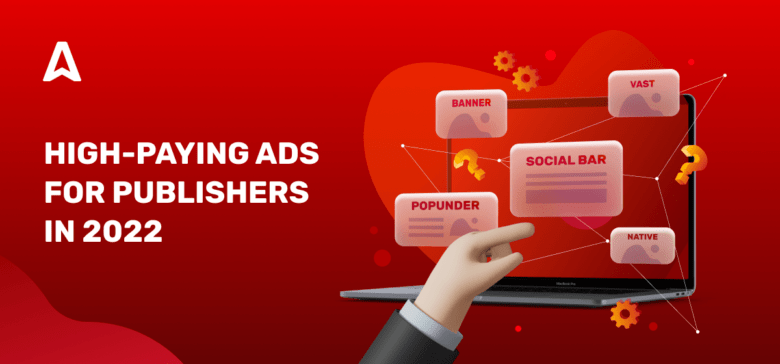You know Adsterra as a global ad network that connects advertisers and publishers. Advertisers VS Publishers: who exactly are they? How do they earn and make profits? Which type of account should you go for to run a campaign and make money on traffic?
Today we’ll make it crystal-clear. Read this ultimate 101 guide to learn all the differences in terms of running the business within an ad network.
Advertisers VS Publishers within an ad network
Ad networks will ask you to choose the type of account and register as an advertiser or as a publisher. But not all of them will explain what they mean by these two statuses. Adsterra has made it easier to choose between the two roles by placing a short description of the accounts’ purposes. But for a deeper understanding, you will get all differences explained later on.


Who are advertisers?
It is better to start with an example. Supposing you’ve developed an app. You now need as many users as possible to download/install it on their devices. If you don’t have a billion subscribers you can invite via email to install the app, you will have to advertise your services.
Advertising means buying users’ clicks, views, and conversions. You may also encounter the term “buy traffic“. What advertisers typically do on an ad network is buy traffic. Here is what they need:
- prepare an offer (what you advertise, which type of conversion you need, how much you are ready to pay, etc.);
- design a landing page with this offer;
- design ad creatives (e.g.: a banner 780×90 px, an in-page push ad, a video ad)
- set up targeting (choosing a slice of users they need), download ad creatives, set up budgets, and pick the timeframe of the ad campaign.
- define budgets and spending limits.
Here we go! Advertisers are those who have some products they want to promote (goods, services, software, etc.). They can be “direct,” which means they own and sell the product they produce. Like Huawei sells its new Honor series. They can also be agents: advertising agencies, resellers, and affiliate marketers.
Advertiser – Definition
An advertiser is someone who wants to sell a service or product and needs advertising space to do so. Advertisers (also merchants and retailers) pay money to those who expose their ads.
How advertisers make money
We know now that companies and agencies pay to display their offers. Actually, they infuse large budgets in the promotion. Global Internet advertising is forecasted to reach $263 million by 2023 (source: Statista.) But what do they get from this spending?

When users see ads, they might want to buy something from an advertiser. That’s when a merchant gets the money. The profit comes when someone buys goods or paid subscriptions, installs paid apps and tools, etc.
Affiliate marketers and agencies, in contrast, make money on the commission they get from conversions. They don’t sell goods, but advertisers pay them for running successful ad campaigns resulting in lots of sales.
Advertisers use the ROI metric (return-on-investment) to measure whether their activities are truly profitable. They tend to keep the spending on advertising lower than money made on sales.
Now let’s sort out the same issue about Publishers.
Who are publishers?
We made out that advertisers are buying the audience’s views, clicks, opt-ins, or other types of actions. They need ad spaces to show users their goods and services. And it is logical to assume that publishers provide those spaces.
Here is the key to getting the difference between advertisers and publishers. Publishers are those who own websites and are ready to display ads to their audience.
Publishers find the best place on web pages to put advertising units. They sign up to an ad network and pick the most suitable and profitable ad format they want to get: Native Banners, In-Page Push, VAST video ads, Popunders, and Direct Links.
How about trying them on? These ad formats have helped lots of publishers grow revenues.
Publisher – Definition
Publishers (or webmasters) are individuals or legal entities providing potential customers via sending traffic to advertisers’ offers. They own websites or have the right to place and rotate ads on them.
While many publishers send web traffic, thousands of them are now shifting to social traffic driving ad views from Facebook, TikTok, and other networks.
How publishers earn
If retailers sell goods, publishers make money on their audience, in other words, their traffic. Webmasters trade the number of times their audience will interact with an advertisement. For instance, it can be one thousand banner impressions. That’s when a well-known CPM rate (cost-per-mille) appears. This term literally means the cost of one thousand impressions.
Webmasters care a lot about CPM as it states how valuable their traffic is and influences their revenue. In our previous article, we examined the major reasons for CPM drops.
Difference between advertisers and publishers
Now we’re going to dry up the details to a simple gist: ad networks connect those who need traffic and those who sell it. Advertisers buy traffic from publishers via ad networks and earn from conversions. Publishers sell traffic via ad networks and earn from ad views. This is far too simple, but we won’t observe all the nuances in this article.
Advertising backstage: where, how, and when to display ads
After the registration, advertisers can set up their first campaign. A campaign is a set of activities that we are going to spell out now.
At Adsterra, advertisers can choose where to expose their offers, how often, and at which price. It means they decide how much they are ready to pay publishers and which ones. How does it happen? There is no magic, just math plus algorithms.
Advertisers use instruments to set up and launch campaigns. With these settings, they can choose where to display ads, who to target, how the ads will look, and how much they are ready to pay for promotion. Furthermore, they decide on actions they will pay for; these can be 1,000 impressions, clicks, purchases, subscriptions, or other conversions.
Pricing models like CPM, CPC, and CPA are used to charge the commission from the advertisers to the benefit of publishers.
Advertisers decide on publishers’ income
As you might have guessed, advertisers aim at reaching the most relevant users – those who will increase their ROI: buy, subscribe, download, or play. If they see that Website A is continually driving them ready-to-pay users, they will bid higher for this traffic. Thus, some traffic costs a lot, and some publishers earn more as they provide advertisers with the best-matching audiences.
Advertisers can even increase or decrease the bid for a specific traffic source; this is called traffic whitelisting and blacklisting.
Ad networks employ algorithms that monitor and control bids. These algorithms will raise the CPM rate when they detect a soaring demand in traffic sent by specific GEOs or publishers.
We’ve reached the most exciting part of the article. Let’s now see how publishers monetize their websites and blogs.
Publishing backstage: how to earn from ads
After the registration, publishers add their websites to the ad network’s database and choose which advertising formats they will place. This way, users will be able to notice ads and click on them.
Social Bar, Native Banners, Popunders, VAST pre-rolls – all of these are formats or units. Unlike banners, pop ads are invisible on web pages; they automatically open an advertising landing page when users click or hover over any area on the page.
Here’s what it looks like. A publisher registers their website and decides on the ad format.

Simply put, every ad format is a piece of code that publishers need to place on the website. With these codes, ads from advertisers are streamed directly to publishers’ websites.
Ad networks can monitor all the URLs and ad placements of each publisher to increase the CPM if traffic from these sources performs excellently. In the same way, they can block placements for driving fraud traffic, or decrease CPM rates if traffic hasn’t brought any results to advertisers.
Publishers supply traffic making ads work
In the ecosystem “advertisers VS publishers,” both roles are extra important. Precisely like advertisers determine how much publishers will earn, publishers provide the most valuable resource – high-quality traffic. Webmasters are priceless as they make goods and services visible, which is crucial in digital marketing.
All commercial organizations strive to attract as much top-grade traffic as possible to contact their offers. They are ready to bid higher for the most prominent GEOs and audiences.
Advertisers VS publishers FAQs
No matter how detailed this article is, dozens of tricky issues will keep disturbing both advertisers and publishers. Let’s clarify at least a couple of them.
Can publishers buy traffic?
Sure they can! Publishers may need to refresh their website users’ demographics or attract more new visitors. In these cases, they will buy search ads to attract the most wanted visitors. As you have guessed, they will act like advertisers. More about website traffic purchasing clues in our guide.
Can a publisher earn from traffic without a website?
We admire you diving so deep into digital marketing! Publishers can turn a profit from social traffic and paid search ads. They need a simple landing page to land all users and a Direct Link they will place on a lander. This way demands skills as you have to deal with paid traffic, so you must earn more than you spend. With our definitive guide on making money on Facebook traffic, you can become a profit ninja.
What tools do advertisers and publishers use?
To make the “advertisers VS publishers” difference more obvious, let’s look at marketing tools and features they use within an ad network.
Tools and solutions that advertisers use
Campaign targeting features
On the campaign’s page, advertisers can select preferable countries, traffic types, devices, and OS they want to target. In other words, they need multiple targeting settings.
Budgeting tools
Another vital option is budget planning and limits; marketing pros need to control how much they pay for traffic. They can set up limits to ad impressions or spending while launching a campaign.
Payment methods
To add funds to their accounts, advertisers use various payment systems. Some prefer paying by card, some will use wire transfer, while many will go for web money payment. Thus, it’s vital to provide advertisers with multiple payment systems.
Advertisers’ statistics
A primary need of any marketer is to keep the core metrics under control. Advertisers monitor campaigns’ efficiency by measuring and comparing volumes of impressions, clicks, CTR, and conversions.
Tools to discover GEOs with the richest traffic
Learning daily volumes for specific GEOs and targets is essential for running a successful campaign. With Adsterra, this task is completed by the Traffic Chart tool.
Traffic and bid estimation tools
While planning a campaign, marketers want to know exactly which payout to choose to get as much traffic as possible without overspending. Therefore, an intelligent tool that could assess the around competitors’ spending and the volume of impressions will help a lot. We provide this tool on the Adsterra Self-Serve Platform — the Traffic Estimator.
Conversion tracking
Tracking methods are used to report conversions. Advertisers use tracking systems to deliver crystal-clear reports about target actions. Trackers like Voluum, BeMob, Cake, and others provide detailed data about each action. With tracking tokens, marketers can send any crucial information, like, for instance, the cost of the click (##COST_CPC## token). Adsterra is integrated with top-grade systems, which means you can set up a postback URL and start collecting data more quickly.
Tools and solutions that publishers use
Websites’ and ad units’ management
Publishers need to have an easy-to-use control center to add advertising codes to their websites. Tools for adding, editing, and managing all ad codes are also essential. So, the main tab on a publisher’s account will be that with all advertising codes.
Publishers’ Statistics
Webmasters also use stats to control their revenues and make changes to ad placements. Basically, they track CPM rates, the number of ad impressions and clicks, best-performing websites, and ad revenue, of course.
Payout methods
We should add one more difference between advertisers VS publishers. While the first ones use payment systems to top up their accounts, the latter need to withdraw the money they earned. There must be a diversity of payment methods, like we have here at Adsterra: PayPal, WireTransfer, Paxum, Webmoney, Bitcoin, Tether.
Additional moneymaking tools
Earning from running ads is cool, but publishers can achieve more if an ad network offers them a referral program. The principle is pretty clear: you recommend other pros to join the ad network, and the ad network pays you a commission. With Adsterra, you have a Referral Program that adds 5% extra income to your regular revenue.
Conclusion
These are the ABCs for understanding the difference between advertisers and publishers in digital marketing. Ad networks are ecosystems where both roles are equal and valuable. To keep the vital balance of profitability, they help advertisers set the best bids to attract as much high-quality traffic to their offers as possible. On the other hand, they must deliver a 100% fill rate with ads for publishers, bringing higher bids to the foreground.
Challenging issues will sometimes arise when you promote services or monetize online. But fear not! Adsterra will be around to help you establish strong relationships with your partners, whether they are advertisers or publishers. Trusted by 21K direct webmasters and running over 20K ad campaigns at a time, Adsterra always finds the perfect traffic-2-offer match.

